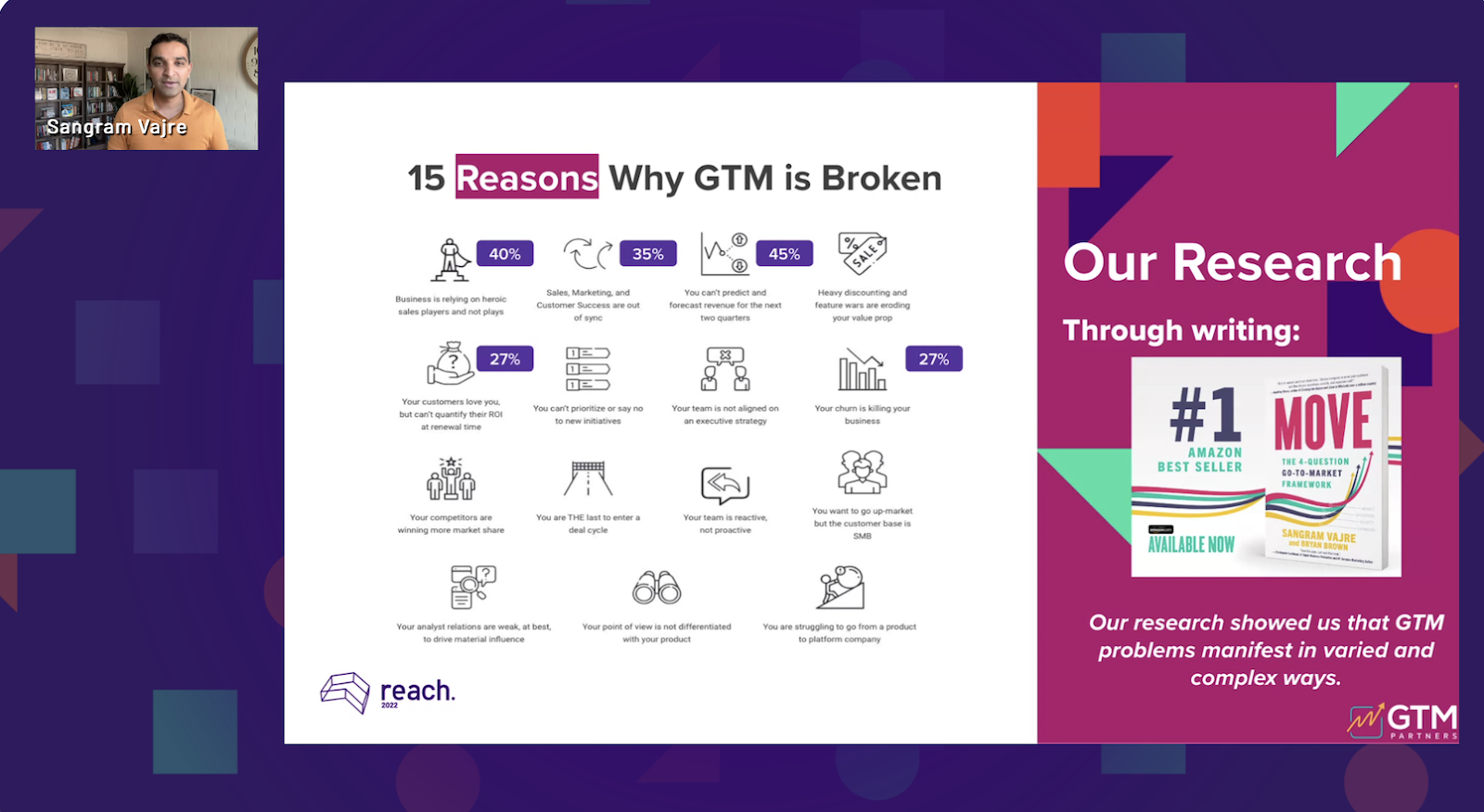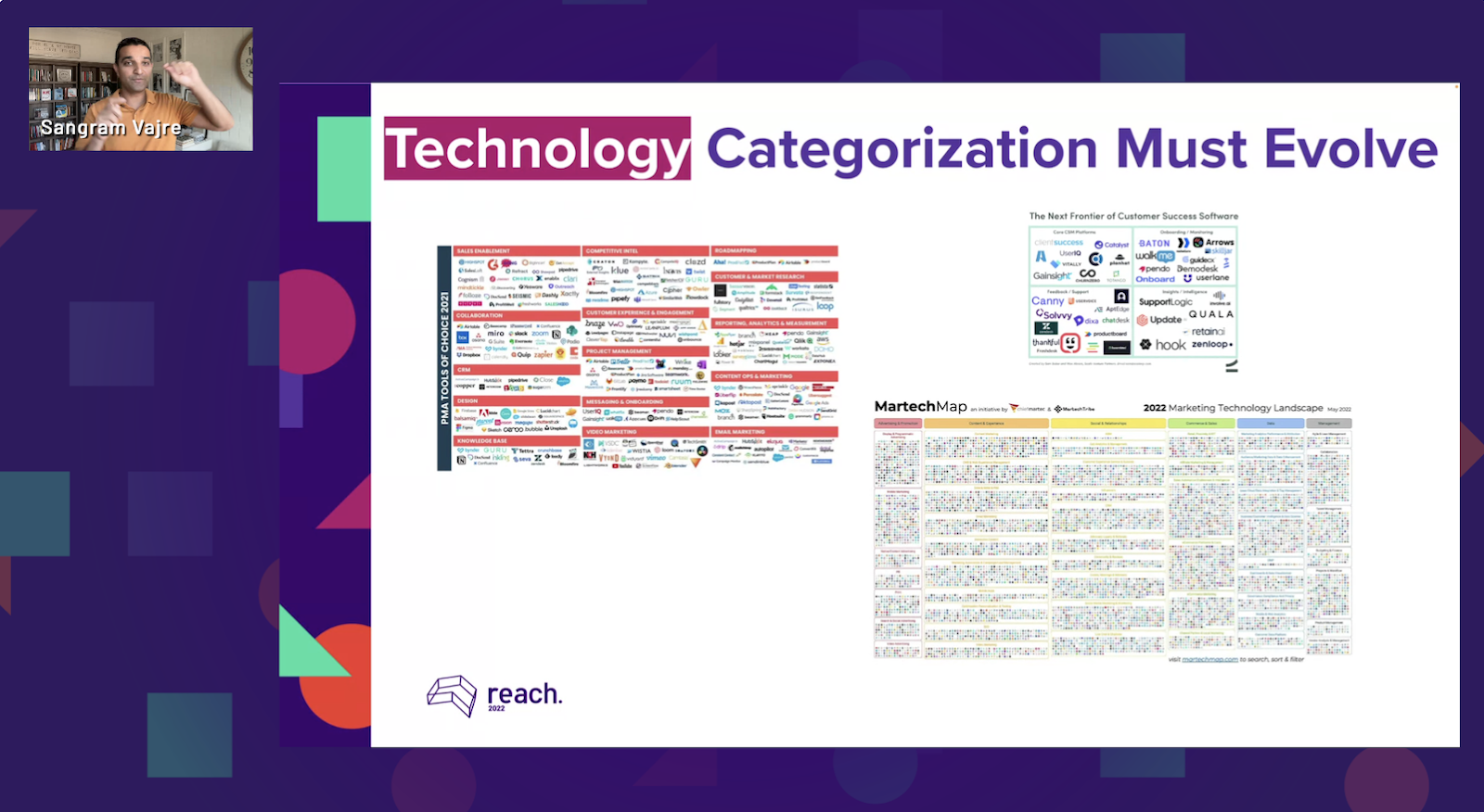Software isn’t the answer to everything – just most things.
Technology has become a key component and necessary part of marketing, allowing for more personalized experiences for customers. Companies use different technology solutions to understand consumer needs, analyze industry data, create products that people want, and enter markets in a way that captures attention and keeps it there.
G2’s 2022 digital Reach conference highlighted some iconic voices in the tech industry and marketing was not left behind. Two marketing professionals outlined why your go-to-market strategy is failing and how you can use software to improve the process. They also touched on the history of marketing tech, along with ways to apply these tools to elevate your marketing game today.
Keep reading to learn more about what Sangram Vajre and Scott Brinker had to say.
Solving a broken go-to-market strategy with Sangram Vajre
You don't have a marketing problem. You don't have a sales problem. You don't have a customer success problem.
You have a go-to-market problem.
Sangram Vajre, co-founder and CEO of GTM Partners, started his session with that sentiment and continued to unpack its meaning with this example:
Company A has $35 million in annual recurring revenue (ARR), and Company B has $50 million in ARR. Which company is more valuable?
Your instinct might be to pick Company B because, after all, more money is better, right? Now, what if Company A has a 120% net retention rate (NRR) and Company B has a 75% NRR? Vajre believes that a strong GTM strategy is the key to improving your NRR.
He explains that Company A will double revenue every five years without needing to onboard any new customers. Company B, on the other hand, would need to double its new customer base at least every year to even keep the lights on.
Once again, mo’ money equals mo’ problems.
“Being intentional is more important than being brilliant,” says Vajre. Putting the emphasis on keeping your customers not only happy, but precisely aware of the value of your product is imperative. NRR directly shows the difference between growth and efficient growth.
Reasons why your GTM strategy is broken
It can be easy to point the finger at different processes and blame them for why your entry into the market failed or didn’t thrive as much as you may have hoped. Vajre pointed out that a lot of different reasons are at play when a GTM strategy doesn’t succeed.

Do you relate to any of these?
- Your business relies heavily on salespeople instead of sales strategies.
- You can’t predict revenue for the next two quarters.
- Your team isn’t aligned on executive strategy.
- You don’t know how to prioritize new initiatives.
- Competitors are messing with your value.
- Your customers can’t justify the return on investment.
- Your churn is killing your business.
- Your sales, marketing, and customer success strategies are out of sync.
- Your team is reactive, not proactive.
Using software for GTM
Entering a market begins far before you actually get there. It’s like doing your homework before school starts.
According to Vajre, every high-performing company has more than one GTM motion ongoing. He uses G2 to start creating a categorization of all the GTM software he needs and to make quick comparisons that help his decision-making.

GTM Partners linked up with G2 and other industry leaders to make the Go-To-Market Impact Study, with lessons that prove just how much experimentation and retention are non-negotiable in this environment.
Marketing software helps companies automate the way they enter the market and stay there. At the end of the day, “success is defined by NRR,” Vajre says.
Because if you get customers but can’t keep them, what’s the point?
Discovering what's next for MarTech in 2023 with Scott Brinker
How much does the past really affect the future?
According to Scott Brinker, Editor of Chiefmartec.com and VP of Platform Ecosystem at HubSpot, the MarTech landscape has become a major quantitative artifact that shows just how much marketing has changed over time. By his estimation, it has grown by over 6,000%.

Marketing + technology = MarTech. It describes all of the software and technology tools that marketing professionals need to do their jobs quickly and efficiently.
For example, marketing automation software helps companies simplify email marketing campaigns, contact marketing targets across multiple channels, create forms for collecting prospect information, and generate performance reports.
What MarTech looks like today
Brinker joked that there are so many marketing software landscapes that there are now pieces of software just for creating and managing those landscapes!
But he isn’t really kidding. With so many software solutions out there and more being developed as we speak, how can anyone pick the right suite of software without either going bonkers or completely breaking the bank?
The new age of MarTech hopes to tackle this issue head-on.
The future of MarTech
According to Brinker’s research, over 500 million apps and services will be created and deployed by 2023. How could any company manage to pick and utilize the right suite of software? Integration!
Software integration is the process of combining different software tools so they can function together as one system. Brinker believes that integration is the future of MarTech and the new key to success in the space.

86%
of the top 100 SaaS companies already have an integration marketplace.
Even 31% of software-as-a-service (SaaS) startups have implemented an integration marketplace. Brinker determined that this is because companies realize just how important consolidating software really is. “The more consolidated platforms become, the easier it is for other platforms to be built,” he says.
Today, apps aren’t built from scratch as much as they used to be; they’re built on top of existing apps specifically for integration purposes.
If integration seems implausible for your company, I hate to break it to you, but it’s not us – it’s you. Brinker believes that only fragile tech stacks are going to break when new applications or data are added. So if integration scares you, look within your current software suite to figure out what’s giving you those insecurities.
As MarTech moves “from silos to symbioses,” the question is not if companies will need to move with the tides, but when.
Go to tech
Whether you’re working on getting yourself into the market or trying to find ways to improve your current processes, the experts agree that the new age of marketing technology is right now. Companies have no choice but to keep up.
TLDR; marketing tech is evolving. Are you coming with?
Hanging out in the market but not getting the results you were looking for? Hear from G2 CMO, Amanda Malko, about how to elevate your market presence and stay successful.
 by Stephen Hoops
by Stephen Hoops
 by Stephen Hoops
by Stephen Hoops
 by Stephen Hoops
by Stephen Hoops